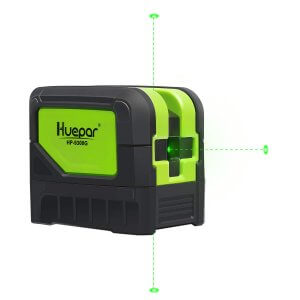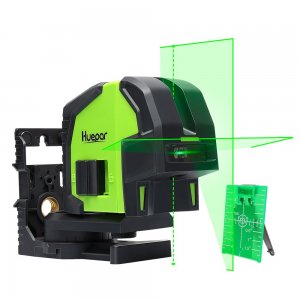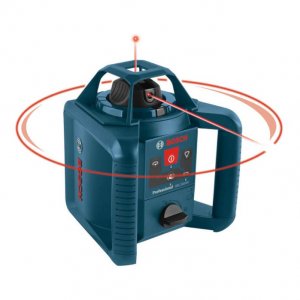Leveling is one of the most basic and important things that you do in construction or any other do-it-yourself project you’ve fancied you can handle.
To make sure that two objects or surfaces are at the same elevation as each other, you’ll need what’s called a “Level”.
Laser levels are devices that, as the name implies, measure in various different ways whether objects are aligned, but they can also be used to check the angles between them as well.
Here are the main types:
1. Dot Laser Level

It’s simply a blocky device that attaches to the surface its placed on through magnets or suction and emits a laser in a specific direction. Most versions are auto-leveling, but there are also some that will need to be manually leveled after placing them upon the surface.
There are variations of the device that come with a secondary, tertiary, and so on and so forth. These lasers are 90° away from each other, so you can set up the Dot Laser Level underneath something and the vertical laser will pinpoint the exact spot that is directly above it.
Alternatively, the 90° can also be on the sides, so you can adjust to make sure you’re working with right angles at a macro scale.
Due to their simplicity, they are designed for indoor work only. To make sure the laser is strong enough to be easily visible in bright daylight, you’ll have to dig deeper into your pocket, but for the average person, a dot laser near the price range of $100 should be more than enough.
They also sometimes come with a receiver, which you can set up against a surface before setting up the laser level. Attaching the receiver to a surface, be it the wall, ceiling, or the floor, makes it easier to check whether the dot is at the place it’s supposed to be or not. Of course, adding a receiver increases the cost of the entire set, so instead, if you’d prefer, you can opt for a reflective laser surface instead.
A reflective surface is usually a plastic square with a bullseye in reflective white in the center. The laser is brighter on the reflective surface, so it helps with more accurate measurements.
2. Line Laser Level

This is done through a series of powerful LED diodes. They can throw the laser up to 30 meters away (Almost 100 feet), and that can be very useful in leveling two different points far away. The distinct advantage this has over the Dot Laser is that instead of making several readings and markings, you just need to make one and get the same result.
The only drawback is that the lasers are limited to only 90°, but they are also capable of emitting a horizontal and vertical laser in the same direction. That means you’ll have a plumb line to work with when using a Line Laser level, but because of the power output, these are rarely built for outdoor use.
More expensive than their dot counterparts, these can go above $600, especially if you intend to use them outdoors. Any of these laser levels, when used outdoors, essentially need a receiver or reflector of some sort to make measurements easy.
As before, these also come with cheap variations that require manual leveling, and expensive variations which level automatically so that every laser they throw off is exactly vertical or exactly horizontal.
The more modern-day versions have a pulse mode that interacts with a receiver gadget to make its use outdoors more viable. You don’t need to see where the laser is landing, as long as you know that’s where it’s landing, after all.
3. Rotary Laser Level

These are incredibly accurate, incredibly powerful, and are sometimes scaled up to a size that would require entire vehicles to move them. They can be upwards of $2000.
They work is by rotating a laser at extremely high velocity, giving the impression of a perfectly circular line. The lines can be both vertical or horizontal, and their angle adjustment means that you can set up an accurate level between both the x-axis and y-axis. This means that the results and measurements are highly reliable, and the tool itself is quite versatile.
If a detector is used which is also known as a receiver, the laser can reach as far as a thousand feet away.
Find the best rotary laser levels here.
Which level is right for you?
In the end, it depends entirely on the kind of project you’re going to be using it for.
Here’s a table to help you decide:
| Line & Dot Lasers | Line Lasers with Receivers | Rotating Lasers | Rotating Grade Lasers | |
|---|---|---|---|---|
| General indoor fit-out | ✅ | ✅ | Some limitations | Some limitations |
| General outdoor site leveling | ❌ | ✅ | ✅ | ✅ |
| Drainage & plumbing | ❌ | ❌ | ❌ | ✅ |
| Concreting | ❌ | ✅ | ✅ | ✅ |
| Earthmoving & civil works | ❌ | ❌ | ✅ | ✅ |
| Site layout/squaring | ❌ | ✅ | Some limitations | Some limitations |
| Plastering | ✅ | ✅ | Some limitations | Some limitations |
| Electrical installation | ✅ | ✅ | ❌ | ❌ |
A line laser can fulfill most of the demands you might have, but a single Rotary Laser level could be necessary.
Larger construction/outdoor projects will definitely need a Rotary Laser level.
If you’re just a homeowner doing jobs around the hose, a simple dot/line laser will be more than enough for your needs.
The lasers are split into different wavelengths and intensity, which can be important if you intend to use them for a long duration due to power costs and whether the natural light in the area is intense. If you buy an inappropriate level with the wrong wavelength and intensity, you could only be able to use it under certain conditions.
For example, if a light color, like blue, at a low intensity, will be nearly invisible if intended to use outdoors. Even indoors it wouldn’t be reliable. Even if you got a receiver, the power behind the laser could be so weak that it won’t be able to pick it up.
Reader Interactions